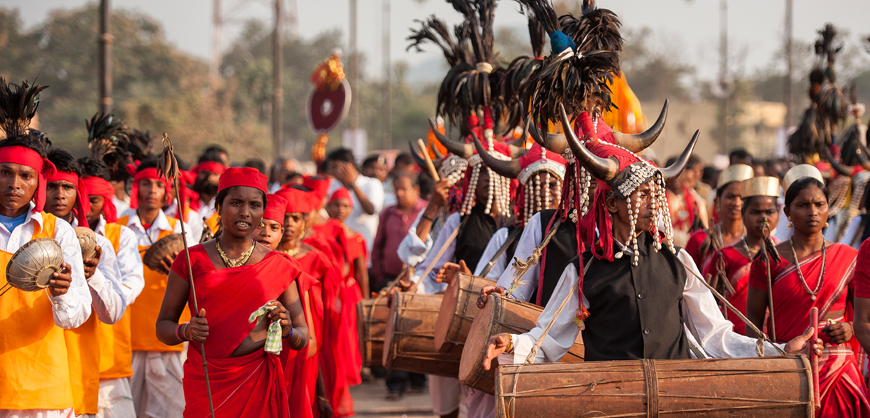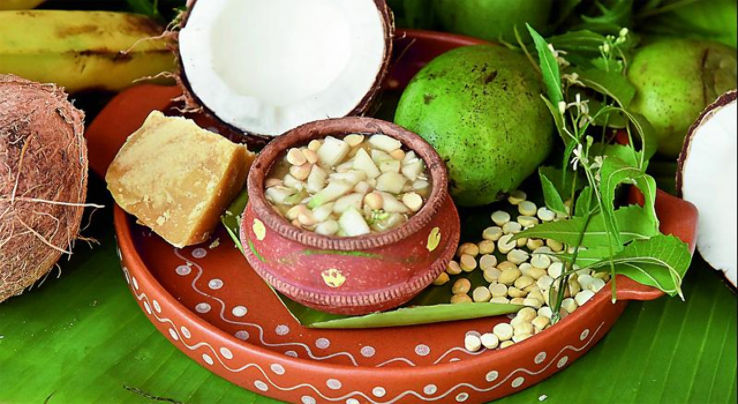In India, we have festivals and celebrations for every occasion. The festivals of India are closely linked with the seasons, agricultural activities, familial relationships, and our belief systems.
We celebrate the start of the spring season with Holi festival and the end of the harvest season with Makara Shankaranti. The death of the cruel demon Narakasura is celebrated as Diwali.
Access Here More Than 1000+ FREE Educational Apps
Raksha Bandhan celebrates the bond between a brother and a sister. While many of the festivals are celebrated nationwide, there are also many festivals that are ethnic to the region or state.
In this “Festivals of India” essay, we shall explore the diverse culture of our nation as we talk about the national festivals of India (state-wise).
1. Andhra Pradesh – Brahmotsavam

Every year, thousands of devotees travel from all parts of the country to Tirupati in Andhra Pradesh for the Brahmotsavam festival. The “Brahma’s Utsavam” is a 9-day festival that usually happens in October. It is based on the legend that Lord Brahma worshiped Lord Vishnu for protecting mankind. The rituals that are conducted during these celebrations thank the Lord and pray for fertility, abundance, and prosperity.
2. Arunachal Pradesh – Dree Festival

The dree festival is celebrated by the Apatani tribe in Arunachal Pradesh. This harvest festival is celebrated on the 5th of July every year. During this festival, people pray to the five deities – Tamu, Metii, Medvr, Mepi, Danyi to ward off pests, epidemics, and other factors that could damage their agriculture and pray for healthy crops. The tribals perform their traditional dance and feast on tangy rice and millet bear.

Bohag Bihu is a 7-day festival that is usually celebrated in April. It marks the beginning of the Assamese New Year and is associated with agricultural harvest. The festival is also called Rongali Bihu. During this week-long celebration, cattle are decorated, dance performances are held, deities are worshiped and feasts are held.

During the Chhath Pooja, people worship the Sun God and his consort, Usha, who are the source of all powers. Prayers are made for prosperity and well being. This pooja usually falls in October – November. Devotees fast during this period and stand in water or sunlight for hours.
5. Chattisgarh – Bastar Dussehra

A festival unique to Chattisgarh, Bastar Dussehra is celebrated for 75 days. It begins on the no-moon day of the Indian month of Shravan (July-August) and ends on the full moon day of the Ashwin month (September – October). This 500-year old festival celebrates tribal gods and goddesses.
6. Goa – Carnival

The Indian version of the famous “Mardi Gras” happens in Goa every February and is called Rio Carnival. Originally a Catholic festival, it has now turned into a huge event that brings in thousands of visitors from all over the world. The highlight of the carnival is the parade that has elaborate floats, bullock carts, horse-drawn carriages, dancing troupes and more.

Janmashtami is a festival that celebrates the birth of Lord Krishna, an avatar of Lord Vishnu. Though this festival is celebrated all over India, it has special significance in Dwarka in Gujarat. Dwarka is believed to be Krishna’s kingdom. During this festival, people visit temples, share sweets with friends and family, sing bhajans and perform folk dances.
8. Himachal Pradesh – Mandi Shivaratri

In Himachal Pradesh, Mandi Shivaratri Fair starts on the day of Shivaratri. Mahashivaratri is a holy occasion for Saivaites all over the country. During this festival, 200 Gods and Goddesses from across Himachal Pradesh are brought to Mandi, which is known as the Varanasi of the Hills. This festival happens during February/March.

Hal Punhya is one of the tribal festivals celebrated in Jharkhand. It happens in January – February and marks the start of the harvest season. This agricultural festival signifies the start of ploughing to sow seeds

Ugadi is a festival that celebrates the beginning of a New Year. This festival is celebrated by the people in Karnataka, Andhra and Telengana and generally falls in March – April. The specialty of this festival is a dish made of jaggery and neem flower buds. It signifies that life is a mix of both sweetness and bitterness, and we should accept both ups and downs in life.

Onam is a 10-day harvest festival celebrated in Kerala. This festival is celebrated by Malayalis all over the world, irrespective of the faith they follow. During Onam, huge rangolis with flowers are created. Boat races, tug of war, music and dance performances, martial art performances and other events are conducted in more than 30 locations in different parts of the state. Onam sadhya (feast) is an important part of the celebrations. It is a 9-course meal that is prepared using local and seasonal vegetables.

Hemis is a Tibetan Buddhism festival that celebrates the birth of Guru Rimpoche (Lord Padmasambhava). This festival happens in Hemis Monastery, Ladakh. During the festival, dancers wearing masks dance to the music of the drums, cymbals and trumpets. The festival happens in July.
13. Maharashtra – Diwali

The festival of lights is celebrated all over India. Each state has different traditions and customs for this festival. In Maharashtra, it is a 5-day festival that begins with Dhanteras. People pray to Lord Ganesha and Goddess Lakshmi for prosperity. After the rituals, crackers are burst and a feast is served.

The Lui-Ngai-Ni festival signifies the start of a New Year for the Naga tribes in Manipur. This seed-sowing festival is celebrated in February. Dances, music performances and cultural programs are held during the celebrations.
15. Meghalaya – Nongkrem dance festival

This 5-day thanksgiving festival of the Khasi tribe is usually held in November. The highlight of this festival is the folk dance of the men and women in their traditional costumes. Sacrifices and offerings are made to God and ancestors during this festival.
16. Nagaland – Hornbill Festival

The Hornbill festival held from the first to the tenth of December brings together the numerous Naga tribes in the state. The festivities include performances by all the tribes, flower shows, Naga wrestling, games and more. The festival was started to preserve the ethnicity and culture of the Naga tribes and promote tourism in Nagaland.

Also known as Mithuna Sankranti, it is a 3-day festival that celebrates womanhood and menstruation. It usually falls in June. As per legend, it is believed that Goddess Earth menstruates during these three days. So, no sowing or agricultural work is done. Women follow rituals that are done during the menstrual period on the first day and the remaining two days, celebrate with feasts and games.

Baisakhi is a Sikh festival celebrated in Punjab. It generally falls in April – May. It is a harvest festival of the farming community and also the day when the tenth Sikh guru, Guru Gobind Singh created the Panth Khalsa-the Order of the Pure Ones. The festivities include cultural programs and feasts.

This Rajasthan festival celebrates womanhood and marriage. It is an 18-day festival that begins right after the festival of colours, Holi. During this festival, unmarried women pray for a good marriage and the married women pray for the well-being of their husbands. Processions and cultural programs are held during this period.

It is a Tibetan festival celebrated during the fourth month of the Tibetan year, which is May – June in the English calendar. During the month, people practice meritorious deeds, avoid killing animals and spread positive thoughts. The highlight of this festival is performing the holy Kora around the Kailash Mountain.

Pongal is a 4-day festival celebrated in January in Tamilnadu. This harvest festival begins with Bhogi, a day when all old things and agricultural waste are burnt and homes cleaned for the new beginning. The second day is Pongal, when people prepare the dish “Pongal” using newly-harvested rice in new pots. Prayers are given to the Sun God. The third day is the “Mattu Pongal” when cows and bulls are bathed and decorated. The famous “Jallikattu” or bull fight happens on this day. On the fourth day, people visit their relatives and share the sweets prepared for the festival.
22. Telangana – Bonalu

People worship Goddess Mahakali during this annual festival that usually falls in July. The women prepare a traditional meal with rice, jaggery and milk and carry it to the temple in earthen pots and offer it to the Goddess. It’s celebrations galore in Golconda Fort during Bonalu.
23. Tripura – Kharchi Pooja

This week-long festival happens during July at Old Agartala. During the festival, the 14 Gods of Tripura are worshipped with offerings and animal sacrifices. Cultural programs and fairs are held during the festival time.
24. West Bengal – Durga Pooja

Durga pooja or Navratri is celebrated all over the country but is of special significance in West Bengal. Huge statues of Goddess Durga slaying the demon Mahishasura are created from clay before the festival. The statues are placed in pandals where people visit and worship. On the last day of the celebration, the idols are immersed in the River Ganges.
Access Here More Than 1000+ FREE Educational Apps
Conclusion
While there are uncountable more festivals in different parts of India, these are the 24 most popular national festivals of India state-wise.
Diversity of the country is reflected in the different ways in which these celebrations take place. If we have missed any important festival, do let us know.
